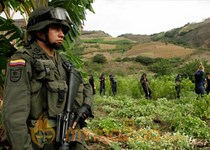In the lowlands surrounding the town of La Hormiga, coca was once king.
Fields of the bright green bushes stretched to the horizon in every direction and farmers were flush with cash. The surrounding municipality was the one with the most coca crops in the country that produced the most cocaine in the world.
This was “ground zero” for Plan Colombia, a massive multipronged effort funded by nearly $10bn in US aid that started in 2000. The plan aimed to recover a country that was in the grips of drug mafias, leftist guerrillas and rightwing militias, and whose institutions malfunctioned and economy faltered.
Fifteen years on, cattle graze where coca once grew by the side of the road and cacao is more easily spotted than coca. Farmer Fulgencio Quenguan traded his coca for fish farming. “I don’t make as much money but no one can take this from me,” he says as he scales a few tilapias for a customer in his own shop in town.
Today, Colombia is a country transformed. It has one of Latin America’s healthiest economies, violence has dropped dramatically and the country is on the verge of ending more than half a century of internal conflict with Farc guerrillas who appear prepared to sign a peace deal in coming months.
At a White House ceremony on Thursday, Barack Obama and Colombian president Juan Manuel Santos will make a pitch for increased aid for Colombia once a peace accord is signed, while celebrating the successes of Plan Colombia.
But here in Putumayo, Plan Colombia has a mixed legacy.
Plan Colombia’s first target was to reduce the amount of coca in Putumayo by half in five years. It did that and more. The total area planted with coca dropped from just over 66,000 hectares (163,020 acres) in 2000 to less than 9,000 hectares (22,230 acres) in 2005.
But the crops and related violence moved elsewhere in the country, and after some 4m hectares (9.88m acres) of coca were sprayed with herbicide in 15 years, coca production is on the rise again and Colombia remains the world’s top producer of coca and cocaine.
“Coca is stubborn,” says farmer Quenguan. He hasn’t grown coca on his 12-hectare (30-acre) farm in the village of Los Laureles for more than 10 years. But there’s one bush that, no matter how many times it has been sprayed with herbicide, no matter how many times he cuts it down, keeps popping back up.
“Bad weeds never die,” he says, reciting an age-old Spanish adage.
Plan Colombia has become a catch-all phrase for several different strategies. It is most widely understood as a US aid package to Colombia which has totaled about $10bn since 2000. More broadly, it was a joint US-Colombian strategy to strengthen the military, state institutions and the economy.
“There is this idea that it is some vast orchestrated project but Plan Colombia doesn’t exist as such,” says Winifred Tate, author of Drugs, Thugs and Diplomats, a study of US policymaking in Colombia. Rather, it has been a series of programs whose emphasis has expanded and recalibrated over the years, she says.
Initially, Plan Colombia was described as a counter-narcotics and military strengthening strategy and the focus was on massive drug crop spraying, building up military capacity and offering some incentives to coca growers to switch to legal crops.
Andres Pastrana, the Colombian president under whom Plan Colombia began, says the strategy was a turning point in the country’s decades-old war. “Before the Plan, security forces were on the defensive and on the verge of military defeat [by guerrillas],” he told the Guardian in an emailed response to questions.
Afraid of getting bogged down in a Vietnam-style quagmire, Congress initially restricted the use of donated helicopters and other hardware strictly to fighting drug production and trafficking. A battalion of 3,000 men trained by US special forces could not be used to combat the guerrillas or paramilitaries unless their targets were clearly protecting drug labs or coca fields.
“Those limitations ... on the use of Plan Colombia caused (operational) problems,” said Pastrana, who will also be at the White House ceremony.
That ended after the 9/11 attacks in New York and Washington, when the US became openly engaged in fighting “narco-terrorism” in Colombia. That is where Plan Colombia did succeed: in helping the Colombian government take control – in some areas for the first time – of its territory, fighting back guerrillas to mountain and jungle redoubts and driving them to begin peace negotiations with the government in 2012.







